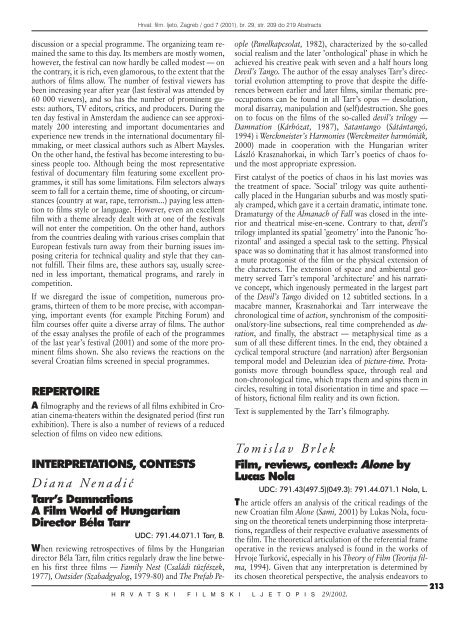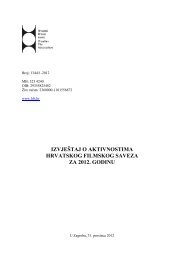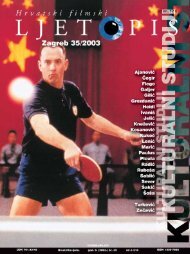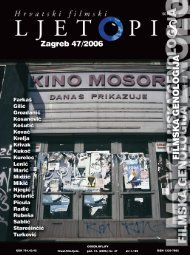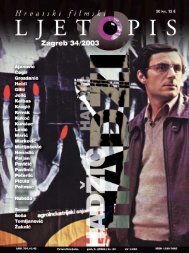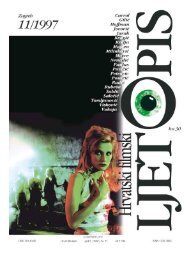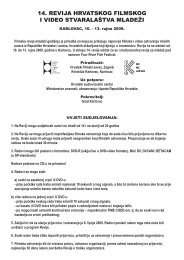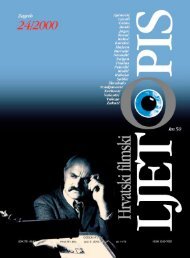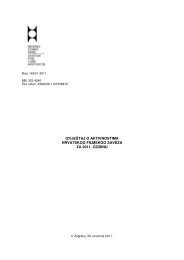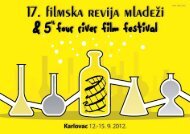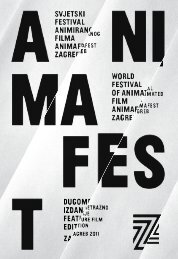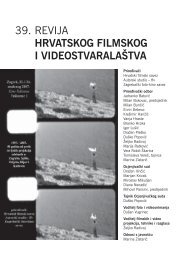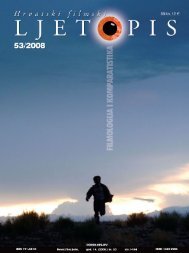You also want an ePaper? Increase the reach of your titles
YUMPU automatically turns print PDFs into web optimized ePapers that Google loves.
discussion or a special programme. The organizing team remained<br />
the same to this day. Its members are mostly women,<br />
however, the festival can now hardly be called modest — on<br />
the contrary, it is rich, even glamorous, to the extent that the<br />
authors of films allow. The number of festival viewers has<br />
been increasing year after year (last festival was attended by<br />
60 000 viewers), and so has the number of prominent guests:<br />
authors, TV editors, critics, and producers. During the<br />
ten day festival in Amsterdam the audience can see approximately<br />
200 interesting and important documentaries and<br />
experience new trends in the international documentary filmmaking,<br />
or meet classical authors such as Albert Maysles.<br />
On the other hand, the festival has become interesting to business<br />
people too. Although being the most representative<br />
festival of documentary film featuring some excellent programmes,<br />
it still has some limitations. Film selectors always<br />
seem to fall for a certain theme, time of shooting, or circumstances<br />
(country at war, rape, terrorism...) paying less attention<br />
to films style or language. However, even an excellent<br />
film with a theme already dealt with at one of the festivals<br />
will not enter the competition. On the other hand, authors<br />
from the countries dealing with various crises complain that<br />
European festivals turn away from their burning issues imposing<br />
criteria for technical quality and style that they cannot<br />
fulfill. Their films are, these authors say, usually screened<br />
in less important, thematical programs, and rarely in<br />
competition.<br />
If we disregard the issue of competition, numerous programs,<br />
thirteen of them to be more precise, with accompanying,<br />
important events (for example Pitching Forum) and<br />
film courses offer quite a diverse array of films. The author<br />
of the essay analyses the profile of each of the programmes<br />
of the last year’s festival (2001) and some of the more prominent<br />
films shown. She also reviews the reactions on the<br />
several Croatian films screened in special programmes.<br />
REPERTOIRE<br />
A filmography and the reviews of all films exhibited in Croatian<br />
cinema-theaters within the designated period (first run<br />
exhibition). There is also a number of reviews of a reduced<br />
selection of films on video new editions.<br />
INTERPRETATIONS, CONTESTS<br />
Diana Nenadi}<br />
Tarr’s Damnations<br />
A Film World of Hungarian<br />
Director Béla Tarr<br />
UDC: 791.44.071.1 Tarr, B.<br />
When reviewing retrospectives of films by the Hungarian<br />
director Béla Tarr, film critics regularly draw the line between<br />
his first three films — Family Nest (Családi tüzfészek,<br />
1977), Outsider (Szabadgyalog, 1979-80) and The Prefab Pe-<br />
Hrvat. film. ljeto, <strong>Zagreb</strong> / god 7 (2001), br. <strong>29</strong>, str. 209 do 219 Abstracts<br />
ople (Panelkapcsolat, 1982), characterized by the so-called<br />
social realism and the later ’onthological’ phase in which he<br />
achieved his creative peak with seven and a half hours long<br />
Devil’s Tango. The author of the essay analyses Tarr’s directorial<br />
evolution attempting to prove that despite the differences<br />
between earlier and later films, similar thematic preoccupations<br />
can be found in all Tarr’s opus — desolation,<br />
moral disarray, manipulation and (self)destruction. She goes<br />
on to focus on the films of the so-called devil’s trilogy —<br />
Damnation (Kárhózat, 1987), Satantango (Sátántangó,<br />
1994) i Werckmeister’s Harmonies (Werckmeiter harmóniák,<br />
2000) made in cooperation with the Hungarian writer<br />
László Krasznahorkai, in which Tarr’s poetics of chaos found<br />
the most appropriate expression.<br />
First catalyst of the poetics of chaos in his last movies was<br />
the treatment of space. ’Social’ trilogy was quite authentically<br />
placed in the Hungarian suburbs and was mostly spatialy<br />
cramped, which gave it a certain dramatic, intimate tone.<br />
Dramaturgy of the Almanach of Fall was closed in the interior<br />
and theatrical mise-en-scene. Contrary to that, devil’s<br />
trilogy implanted its spatial ’geometry’ into the Panonic ’horizontal’<br />
and assinged a special task to the setting. Physical<br />
space was so dominating that it has almost transformed into<br />
a mute protagonist of the film or the physical extension of<br />
the characters. The extension of space and ambiental geometry<br />
served Tarr’s temporal ’architecture’ and his narrative<br />
concept, which ingenously permeated in the largest part<br />
of the Devil’s Tango divided on 12 subtitled sections. In a<br />
macabre manner, Krasznahorkai and Tarr interweave the<br />
chronological time of action, synchronism of the compositional/story-line<br />
subsections, real time comprehended as duration,<br />
and finally, the abstract — metaphysical time as a<br />
sum of all these different times. In the end, they obtained a<br />
cyclical temporal structure (and narration) after Bergsonian<br />
temporal model and Deleuzian idea of picture-time. Protagonists<br />
move through boundless space, through real and<br />
non-chronological time, which traps them and spins them in<br />
circles, resulting in total disorientation in time and space —<br />
of history, fictional film reality and its own fiction.<br />
Text is supplemented by the Tarr’s filmography.<br />
Tomislav Brlek<br />
Film, reviews, context: Alone by<br />
Lucas Nola<br />
UDC: 791.43(497.5)(049.3): 791.44.071.1 Nola, L.<br />
The article offers an analysis of the critical readings of the<br />
new Croatian film Alone (Sami, 2001) by Lukas Nola, focusing<br />
on the theoretical tenets underpinning those interpretations,<br />
regardless of their respective evaluative assessments of<br />
the film. The theoretical articulation of the referential frame<br />
operative in the reviews analysed is found in the works of<br />
Hrvoje Turkovi}, especially in his Theory of Film (Teorija filma,<br />
1994). Given that any interpretation is determined by<br />
its chosen theoretical perspective, the analysis endeavors to<br />
213<br />
H R V A T S K I F I L M S K I L J E T O P I S <strong>29</strong>/<strong>2002</strong>.


